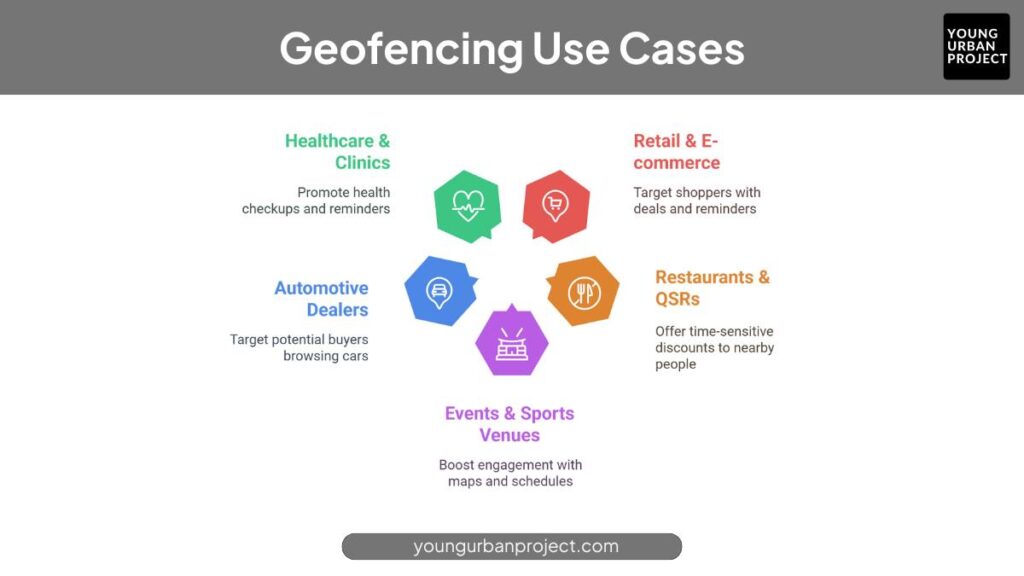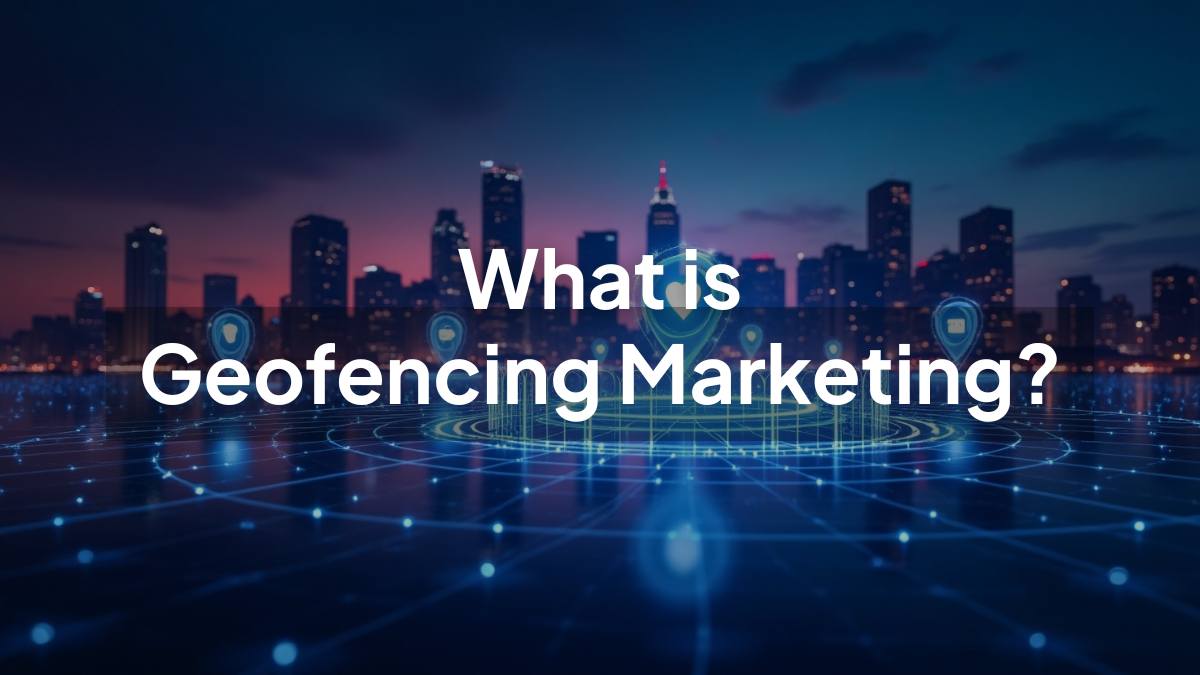Imagine this: You’re walking past a coffee shop and suddenly get a notification on your phone: “Hey, it’s latte o’clock! Show this message for 20% off your favorite brew.” That’s Geofencing Marketing in action, and it’s changing the game for businesses, big and small.
In today’s mobile-first world, where most of us are practically inseparable from our smartphones, brands have a unique chance to connect with people based on where they are – in real time. According to Statista, the number of smartphone users worldwide is expected to surpass 7.7 billion by 2028. That’s an enormous audience for location-based marketing to tap into.
Let’s break it all down.
Geofencing marketing is a location-based strategy that allows businesses to send promotions, ads, or alerts to mobile users when they enter a specific geographic area.
Think of it like drawing an invisible fence around a physical location, a coffee shop, gym, or retail store. Once someone walks into that “fence” with their phone, they’re fair game for a brand’s message.
Why it matters now
Consumers are constantly on the move, and their buying decisions are heavily influenced by context, where they are, what they’re doing, what time it is. Geofencing taps into that context in real time.
Quick stat for perspective
53% of shoppers visited a specific retailer after receiving a location-based message. (Source)
Table of Contents
What is Geofencing Marketing? (Explained Simply)
Let’s strip it down.
At its core, Geofencing Marketing is about drawing a digital boundary (aka a “geofence”) around a real-world location. When someone with a GPS-enabled device (like a smartphone) enters that area, they trigger an event, such as receiving a push notification, a display ad, or even a text.
How it’s different from “traditional” location-based ads
While geotargeting uses broader location data (like targeting an entire city or ZIP code), geofencing zeroes in on micro-locations, like a single block or specific store.
The tech behind it (without the jargon)
- GPS: Uses satellite data to pinpoint location, accurate up to a few meters.
- RFID (Radio Frequency Identification): Often used indoors (e.g., in stores) for very close-range tracking.
- Wi-Fi & Bluetooth: Used for more precise proximity marketing (e.g., beacons inside malls or stadiums).
You don’t need to be a techie to use it, the platforms and tools handle most of this in the background.
How Does Geofencing Marketing Work?
It’s a 3-part mechanism:
- Define the perimeter – Set a radius around a location (could be 50 meters or 5 km).
- Set the trigger – What happens when someone enters or exits the area? (E.g., ad display, app notification).
- Deliver the message – Send your ad, coupon, or content in real-time.
Common integrations
- Mobile apps (especially brand apps or loyalty programs)
- Google Ads and Facebook Ads
- SMS platforms
A simplified step-by-step
- User enters the geofence with location services ON
- System detects device location via GPS or Wi-Fi
- Predefined trigger is activated (like serving a display ad or push alert)
- User sees the message → ideally takes action (e.g., visits your store)
Key Components of a Geofencing Campaign
To run a geofencing ad campaign, here’s what you’ll need:
1. Location Boundary
Your virtual fence, could be as tight as 100 meters or as wide as an entire mall complex.
2. Trigger Mechanism
This is what kicks in when someone enters (or exits) the geofenced area. Options include:
- Mobile push notification
- Display ad on websites/apps
- SMS or email
- In-app experience
3. Audience Targeting
You can refine by:
- Age, gender, interests
- Past app behavior
- Time of day
- Day of week
4. Platform Integration
Run campaigns via:
- Google Ads: Location extensions and radius targeting
- Meta (Facebook/Instagram): Location targeting combined with interests
- Custom platforms: xAd (now GroundTruth), Radar, PlotProjects
Top Benefits of Geofencing Marketing
Hyper-targeted advertising
Geofencing lets you zero in on people in a specific place at a specific time – no more wasting ad spend on irrelevant audiences. You’re reaching users when they’re most likely to take action, like walking past your store or standing near a competitor’s outlet.
Real-time engagement with high intent
Since the interaction happens the moment someone enters your geofence, it hits them when they’re close to making a decision. Whether it’s a last-minute promo or a reminder to stop by, this immediacy can nudge action faster than traditional ads.
Drive more foot traffic and offline conversions
This is where digital meets physical. You’re not just getting clicks; you’re literally getting people through your doors. Especially for brick-and-mortar businesses, geofencing bridges the online-to-offline gap and helps track actual walk-ins tied to specific campaigns.
Better return on ad spend (ROAS)
With tighter targeting and more relevant messaging, you naturally reduce waste in your campaigns. You’re not paying to reach random people – you’re connecting with folks who are nearby, potentially interested, and likely to convert. That efficiency tends to lift your overall ROI.
Clearer campaign insights and analytics
Geofencing tools provide detailed data on who entered your location, how long they stayed, and if they took action. It’s incredibly helpful for evaluating what’s working – or not – so you can fine-tune your approach and continuously improve your results.
Popular Use Cases Across Industries

1. Retail & E-commerce
Retailers can geofence shopping malls, busy streets, or even competitor stores. Trigger instant deals or reminders to check out your store, and bring digital traffic straight to your physical location. It’s especially effective during peak shopping seasons or product launches.
Also Read: Advantages and Disadvantages of E-Commerce
2. Restaurants & QSRs (Quick-Service Restaurants)
Restaurants can serve time-sensitive offers like lunch combos or happy hour discounts to people walking nearby. Geofencing can even help steal attention from rival chains- think of it like waving a sign just as someone’s deciding where to eat.
3. Events & Sports Venues
Marketers geofence stadiums, festivals, or conference centers to boost in-event engagement. From maps and schedules to exclusive vendor deals or AR experiences, real-time messaging enhances the attendee experience while also driving booth visits or merchandise sales.
4. Automotive Dealers
Car dealerships often geofence competitor locations or nearby shopping centers to target potential buyers actively browsing cars. They can push trade-in offers, test drive bookings, or finance deals that make someone think twice before walking into the competitor’s showroom.
5. Healthcare & Clinics
Clinics or local healthcare providers can geofence surrounding residential areas or gyms to promote health checkups, vaccination drives, or seasonal health reminders. It’s a great way to keep your clinic top-of-mind when someone nearby might actually need you.
Geofencing Marketing Examples from Real Brands
Starbucks: Commuter-Focused Push Offers
Starbucks used geofencing to target commuters during morning and evening rush hours. If someone was passing by a store with the app installed, they’d get timely offers for coffee or snacks – turning the daily commute into a sales opportunity.
Also Read: Starbucks Case Study
Sephora: Competitive Targeting with Precision
Sephora geofenced rival beauty stores and shopping centers. When a shopper came near a competitor, they’d receive app-based push notifications with personalized offers or loyalty perks – a subtle yet smart way to tempt customers to reconsider where they’re buying their makeup.
Burger King: “Whopper Detour” Campaign
Burger King famously ran a geofencing stunt where they geofenced McDonald’s locations. If someone opened the BK app within 600 feet of a McDonald’s, they got a Whopper for just one cent. It was cheeky, viral, and drove tons of app downloads and visits.
Also Read: McDonald’s Case Study
Local Gyms: Hyperlocal Fitness Ads
Smaller gyms often geofence nearby parks, fitness stores, or even competing gyms. When people finish a jog or exit a fitness class, they might receive offers for a free trial session or personal training consult. It’s timely, relevant, and often leads to walk-ins.

Enroll Now: Advanced Digital Marketing Course
Geofencing vs. Geotargeting: What’s the Difference?
| Aspect | Geofencing | Geotargeting |
| Definition | Sets a virtual boundary around a physical location to trigger real-time actions | Targets users based on general geographic areas like cities or ZIP codes |
| Precision | High – down to 50–100 meters or a specific building | Medium – focuses on broader areas like neighborhoods, cities, or regions |
| Trigger Type | Event-based (entry/exit of geofence activates the message) | Rule-based (ads shown to users in a defined location, regardless of movement) |
| Best Use Cases | Real-time offers, store visits, events, proximity-based alerts | Regional promotions, language targeting, market expansion |
| Device Requirement | Requires location services (GPS, Wi-Fi, or Bluetooth) to be enabled | Doesn’t require active device tracking – based on IP address or user profile |
| Engagement Timing | Immediate – as users enter or exit the area | Passive – users see ads while browsing or scrolling in that location |
| Ad Delivery Method | Push notifications, in-app alerts, SMS, dynamic mobile ads | Display ads, search ads, social ads targeting a region |
| Complexity | Slightly more technical (especially for app-based triggers) | Easier to set up via ad platforms like Google or Facebook |
| Ideal For | Brick-and-mortar stores, QSRs, live events, app-based campaigns | E-commerce brands, service-based businesses, city-wide campaigns |
| Privacy Concerns | Higher – often requires user consent due to precise tracking | Lower – usually relies on anonymized location data |
Best Platforms and Tools for Geofencing Ads
Platforms you can explore:
- Google Ads: Radius targeting around business locations.
- Meta Ads: Combines detailed user data + location-based delivery.
- GroundTruth (formerly xAd): Specializes in foot traffic analytics and real-time ads.
- Radar: Great for app-based geofencing and location triggers.
- PlotProjects: Developer-friendly geofencing SDK.
Also Read: Top 25 Content Marketing Tools
Key features to look for:
- Real-time tracking
- Behavioral targeting
- Cross-platform reach (web + mobile)
- Analytics dashboard
How to Set Up a Geofencing Campaign (Step-by-Step)
- Choose your geofence
Set a radius, around your store, competitor location, or a popular event. - Set your triggers
Decide what happens: notification, ad, SMS, etc. - Create your ad creatives
Keep it short, relevant, and actionable. Personalize it if possible. - Choose your platform
Depending on where your audience is: Google, Facebook, or custom tools. - Launch & monitor
Watch how people interact, optimize based on engagement, and tweak your radius or timing if needed.
Challenges and Limitations to Consider
- Privacy compliance: Must adhere to GDPR, CCPA, and similar laws. Always get user consent.
- Battery drain: Location tracking can use power, especially with constant GPS.
- Ad fatigue: Don’t bombard users. Time your messages well.
- Rural limitations: Geofencing is most effective in densely populated areas with lots of foot traffic.
Best Practices for Successful Geofencing Campaigns
- Be hyper-precise with your boundaries.
- Combine behavioral + location data for smarter targeting.
- Keep messages short, relevant, and timely.
- Always test creatives, timing, and locations.
- Optimize in real-time based on analytics.
The Future of Geofencing in Digital Marketing
- AI-powered personalization: Using real-time behavior and location to serve smarter messages.
- Voice + geolocation: Think Siri or Alexa suggesting nearby deals as you drive.
- AR + Geofencing: Imagine unlocking AR experiences when you walk into a store or event.
- Customer journey mapping: Sync geofencing with CRM tools to map user behavior across online and offline worlds.
Also Read: The Future of Digital Marketing
FAQs: Geofencing Marketing
1. What is geofencing marketing, and how does it work?
Geofencing marketing uses GPS, Wi-Fi, or mobile data to create a virtual boundary around a real-world location. When someone enters that area with their smartphone, it triggers a specific action, like a push notification or ad, making it a powerful real-time engagement tool.
2. Is geofencing marketing legal?
Yes, as long as you follow privacy laws and get user consent (especially for app-based tracking).
3. Do I need a mobile app to run geofencing campaigns?
Nope. Platforms like Google and Facebook allow geofencing without needing a mobile app, though apps do give more control.
4. What is the difference between geofencing and geotargeting?
Geofencing sets a digital boundary and triggers actions as people cross into it. Geotargeting sends ads based on broader location data like city or state.
5. How accurate is geofencing technology today?
Geofencing can be accurate within a few meters, depending on the device, network, and location settings. GPS is typically the most precise, while Wi-Fi and Bluetooth can improve accuracy in dense or indoor areas. The better the signal, the more reliable the targeting.
6. What platforms support geofencing marketing campaigns?
Popular platforms include Google Ads, Meta (Facebook/Instagram), and specialized tools like GroundTruth, Radar, and PlotProjects. These tools let you define geofences, create triggers, and serve location-based ads across web, mobile, and in-app channels, with analytics to measure performance.

